Influence of Different Particle Size and Rock Block Proportion on Microbial-Solidified Soil–Rock Mixture
Abstract
1. Introduction
2. Microbial Improvement Test of Soil–Rock Mixture
2.1. Bacterial Liquid
2.2. Cementation Reagent
2.3. Silt and Rocks
2.4. Test Plan
2.5. Microscopic Analysis of Soil–Rock Mixture Solidified by Microorganisms
3. Test Results and Microscopic Observation Analysis
3.1. Unconfined Compressive Test Results of Soil–Rock Mixture
3.2. Influence of Rock Block Proportion on Microbial-Solidified Soil–Rock Mixture
- The bearing capacity of the soil–rock mixed column cemented is related to the size of the pores between the soil and rock. Due to the small particle size of the silt, it is in close contact with the rock when it is mixed, which increases the rock content and increases the pore space in the sample. Sporosarcina pasteurii are aerobic bacteria that increase pore space. It is conducive to the combination of bacteria and calcium ions in the cementing solution and the formation of calcium carbonate crystals on the bacterial surface film, which consolidates the surrounding soil and rocks and increases the strength of the sample.
- The bearing strength of the soil–rock mixture is related to the amount of rock block proportion, and the strength and deformation mechanism during shearing are also different with different rock block proportions [74]. For the samples with rock content of 20% and 30%, the content of boulders is low, and the content of silt is high. During the loading process, the silt and the boulder are stressed together, the arrangement of the particles is tight due to the adjustment of the position between the particles, and the macroscopic performance is the shrinkage of the sample volume. As the small particles cohesively break down and move, the sample reaches its peak and completes the test. For the samples with rock block proportions of 50% and 60%, the content of boulder particles is high. The main reason is that large pores will appear in the sample of the block rock particles. In the initial stage of loading, the block rock is first subjected to pressure, and the silt is temporarily “protected” in the pores under the “cover” of the block rock particles. As you continue to load and increase the stress, the bonding between particles is destroyed, the pores are reduced, the particles are dislocated, and the sample volume is visually compressed.
- In the soil–rock mixture, the silt particles are small. Under the action of loading stress, after the pores are destroyed, the bound water increases due to the shrinkage of the pores, and the bond strength between particles is reduced. As the stress increases, the volume shrinks, and the large particles re-contact to increase the bond strength again so that the sample reaches the peak value quickly, and the axial strain of the sample reaches the peak value is small.
- During the stress loading process at a constant rate, the soil–rock mixture is not a uniform carrier of the medium, and the edges and corners of the blocks are first subjected to pressure during the loading process. The stress on the surface of the sample is uneven. With the increase in the stress load, the stress–strain curve shows a jagged upward trend and peak value.
- It can be observed from Figure 6 that the unconfined compressive strength of the microbially cemented soil–rock mixture with the size of 0.2–0.4 cm and 0.4–0.6 cm of the boulders reaches the highest. They are 10.3 kPa and 9.6 kPa, respectively, both with a rock block proportion of 50%. The unconfined compressive strength of the microbial cemented soil–rock mixture with a particle size of 0.6–0.9 cm reaches the highest unconfined compressive strength of 9.4 kPa, with a rock block proportion of 60%.
3.3. Influence of Rock Particle Size on Microbial-Solidified Soil–Rock Mixture
- Looking at Figure 7, Figure 8 and Figure 9 below, under the condition that the bacterial solution concentration, cementation reagent concentration, and solution ratio remain unchanged when the rock block proportion is 50% for the soil–rock mixture with a particle size of 0.2–0.4 cm, as the sample is loaded, the stress increases with the increase in the strain. After reaching the peak, the stress gradually decreases, and the loading rate remains unchanged; therefore, the earliest maximum bearing capacity of the three particle sizes is D3-D2-D1, respectively; that is, the sample with a particle size of 0.6–0.9 cm shows a peak first, followed by a sample with a particle size of 0.4–0.6 cm, and finally a soil–rock mixture sample with a particle size of 0.2–0.4. When the rock block proportion is 60%, the earliest time for the three particle sizes to show the maximum bearing capacity is when D1, D2, and D3 show their peaks at the same time; that is, the sample with a particle size of 0.2–0.4 cm reaches the maximum bearing capacity first, and the sample with a particle size of 0.4–0.6 cm and a particle size of 0.6–0.9 cm basically has the maximum bearing capacity at the same time. The soil–rock mixture mixed with large-sized boulders has a large pore space. When compressed and squeezed, the internal pore space will be destroyed first, and the soil–rock mixture with small-sized boulders will reach the maximum bearing capacity faster than that;
- It can be observed in Figure 9 that under the same loading rate and the same rock block proportion, in the rock block proportion of 20%, 30%, 40%, and 50%, under the same proportion of rock, the unconfined compressive strength decreases with the increase in particle size. When the rock content is 60%, the value of unconfined compressive strength first decreases and then increases with the increase in particle size. In the samples with low rock block proportion, the silt content is high, and the overall force is more inclined to the properties of silt during the loading and stressing process. During the compression process, the pores between the particles are destroyed, the bound water increases due to the shrinkage of the pores, and the bonding strength between the particles decreases, making it easier to be destroyed;
- When the rock block proportion is low, the difference between the particle size ratio of the rock with small particle size and the soil particle size is relatively small, and it is easier to be cemented with the bacteria liquid to form a block. The compressive strength of the soil–rock mass is enhanced, so the unconfined compressive strength of the soil–rock mixture containing small-diameter rocks is higher than that of the soil–rock mixture containing large-diameter rocks under the same conditions. In the case of high rock block proportion, the large particle size of the rock and the soil particle size gap is large, and the pore space is large, giving the bacteria liquid more space for cementation and the required oxygen. At the same time, under the consolidation pressure of irregular boulders, the rocks with larger particle sizes have more particle contact points than those with smaller particle sizes. Under the loading speed of the same rate, the soil–rock mixture with large particle size is more easily broken due to the contact point, forming a stronger particle structure, and its unconfined compressive strength is greater than that of the soil–rock mixture with smaller particles.
3.4. Microscopic Observation
4. Conclusions
- The soil–rock mixture is not a uniform carrier of the medium, and the stress on the surface of the sample is uneven. With the increase in the stress load, the stress–strain curve shows a zigzag upward trend and peak value;
- The cementation ability of soil and rock is related to the pore size between soil and rock. When the rock particle size is the same, the higher the proportion of block stone is, and the more pores between soil and rock particles, which is conducive to microbial cementation and mineralization and improves the sample strength;
- When the rock content is low, the difference between the particle size ratio of small-size rock and the particle size of soil is relatively small, which makes it easier to cement with a bacterial solution to form a block, enhancing the compressive capacity of soil and rock mass. When the rock content is high, the particle size difference of large rock soil particles is large, the pore space is large, and the oxygen is sufficient. At the same time, the large particle size rock has more particle contact points than the small particle size rock, so its unconfined compressive strength is large. When the rock content is the same, the pore space of the soil–rock mixture mixed with large-diameter boulders is larger than that of the soil–rock mixture containing small particles. When the sample is compressed, the pore space inside the sample mixed with large boulders is first destroyed, and the maximum bearing capacity of the small boulder soil–rock mixture is faster than that of the small boulders;
- When the rock content is 20–50%, the unconfined compressive strength decreases with the increase in particle size. When the rock block proportion is 60%, the value of unconfined compressive strength first decreases and then increases with the increase in particle size. In the samples with a low proportion of rock blocks, the overall force is more inclined to the nature of silt. In the process of compression, the pores between particles are destroyed. Due to the shrinkage of pores, the bound water increases, and the binding strength between particles decreases, making them easier to be destroyed;
- Among the soil–rock mixture samples, the unconfined compressive strength of the microbially cemented soil–rock mixture with particle size of 0.2–0.4 cm and 0.4–0.6 cm reaches the highest at 50% rock block proportion. The unconfined compressive strength of the microbially cemented soil–rock mixture with a rock particle size of 0.6–0.9 cm reaches the highest at 60% rock block proportion;
- Microbial mineralization technology can effectively strengthen the adhesion between soil and rock particles. Both SEM and XRD test results proved that Sporosarcina pasteurii could effectively induce the formation of calcium carbonate, and crystals are formed at the pores of the particles to improve the mechanical properties of the soil. Small particles of rocks are combined with silt, the cementation effect is better under the action of microbial mineralization, and the content of calcium carbonate crystals generated is higher than the crystals generated by large particles and silt under the action of mineralization.
Author Contributions
Funding
Institutional Review Board Statement
Informed Consent Statement
Data Availability Statement
Conflicts of Interest
References
- Medley, E.; Goodman, R.E. Estimating the block volumetric proportions of melanges and similar block-in-matrix rocks (bim-rocks). In Proceedings of the 1st North American Rock Mechanics Symposium, Austin, TX, USA, 1–3 June 1994. [Google Scholar]
- Yang, G.-Q.; Liu, H.; Zhou, Y.-T.; Xiong, B.-L. Post-construction performance of a two-tiered geogrid reinforced soil wall backfilled with soil-rock mixture. Geotext. Geomembr. 2014, 42, 91–97. [Google Scholar] [CrossRef]
- Zhang, Z.-L.; Xu, W.-J.; Xia, W.; Zhang, H.-Y. Large-scale in-situ test for mechanical characterization of soil–rock mixture used in an embankment dam. Int. J. Rock Mech. Min. Sci. 2016, 86, 317–322. [Google Scholar] [CrossRef]
- Fan, J.; Wang, D.; Qian, D. Soil-cement mixture properties and design considerations for reinforced excavation. J. Rock Mech. Geotech. Eng. 2018, 10, 791–797. [Google Scholar] [CrossRef]
- Zhang, F.; Liu, Z.; Chen, Y.; Chen, L.; Huang, X.; Bai, Y.; Shi, C.; Zhou, T. Numerical simulation of mutually embedded set-tlement in miscellaneous fill. Adv. Civ. Eng. 2020. [Google Scholar] [CrossRef]
- Pitilakis, D.; Anastasiadis, A.; Vratsikidis, A.; Kapouniaris, A.; Massimino, M.R.; Abate, G.; Corsico, S. Large-scale field testing of geotechnical seismic isolation of structures using gravel-rubber mixtures. Earthq. Eng. Struct. Dyn. 2021, 50, 2712–2731. [Google Scholar] [CrossRef]
- Yang, Z.; Li, S.; Jiang, Y.; Hu, Y.; Liu, X. Shear Mechanical Properties of the Interphase between Soil–Rock Mixtures and Benched Bedrock Slope Surfaces. Int. J. Géoméch. 2022, 22, 04022047. [Google Scholar] [CrossRef]
- Kai, C.; Xiang, J. Effect of coarse grain content on the dynamic shear modulus and damping ratio of mixed soil under seismic load in western Sichuan. China J. Highw. Transp. 2019, 32, 123. [Google Scholar]
- Ji, X.; Han, B.; Hu, J.; Li, S.; Xiong, Y.; Sun, E. Application of the discrete element method and CT scanning to investigate the compaction characteristics of the soil–rock mixture in the subgrade. Road Mater. Pavement Des. 2020, 23, 397–413. [Google Scholar] [CrossRef]
- Imran, A.; Nakashima, K.; Evelpidou, N.; Kawasaki, S. Durability Improvement of Biocemented Sand by Fiber-Reinforced MICP for Coastal Erosion Protection. Materials 2022, 15, 2389. [Google Scholar] [CrossRef]
- Tsai, C.-P.; Ye, J.-H.; Ko, C.-H.; Lin, Y.-R. An Experimental Investigation of Microbial-Induced Carbonate Precipitation on Mitigating Beach Erosion. Sustainability 2022, 14, 2513. [Google Scholar] [CrossRef]
- Wang, X.; Li, C.; He, J. A highly effective strain screened from soil and applied in cementing fine sand based on MICP-bonding technology. J. Biotechnol. 2022, 350, 55–66. [Google Scholar] [CrossRef] [PubMed]
- Zhang, J.; Shi, X.; Chen, X.; Huo, X.; Yu, Z. Microbial-Induced Carbonate Precipitation: A Review on Influencing Factors and Applications. Adv. Civ. Eng. 2021, 2021, 1–16. [Google Scholar] [CrossRef]
- Leeprasert, L.; Chonudomkul, D.; Boonmak, C. Biocalcifying Potential of Ureolytic Bacteria Isolated from Soil for Biocementation and Material Crack Repair. Microorganisms 2022, 10, 963. [Google Scholar] [CrossRef] [PubMed]
- Wang, Y.; Wang, G.; Wan, Y.; Yu, X.; Zhao, J.; Shao, J. Recycling of dredged river silt reinforced by an eco-friendly technology as microbial induced calcium carbonate precipitation (MICP). Soils Found. 2022, 62, 101216. [Google Scholar] [CrossRef]
- Liu, P.; Shao, G.; Huang, R. Mechanical Properties and constitutive model of MICP-cemented sand. J. Southeast Univ. Nat. Sci. Ed. 2019, 49, 720–726. [Google Scholar]
- Zhao, Y.; Wang, Q.; Yuan, M.; Chen, X.; Xiao, Z.; Hao, X.; Zhang, J.; Tang, Q. The Effect of MICP on Physical and Mechanical Properties of Silt with Different Fine Particle Content and Pore Ratio. Appl. Sci. 2021, 12, 139. [Google Scholar] [CrossRef]
- Mukherjee, S.; Sahu, R.B.; Mukherjee, J. Effect of Biologically Induced Cementation via Ureolysis in Stabilization of Silty Soil. Geomicrobiol. J. 2021, 39, 66–82. [Google Scholar] [CrossRef]
- Shen, T.; Wang, S.; Xue, L.; Li, X.; He, B. An experimental study of sandy clayey purple soil enhanced through microbi-al-induced calcite precipitation. Rock Soil Mech. 2019, 40, 3115–3124. [Google Scholar]
- Liu, X.; Pan, C.; Yu, J.; Fan, J. Study on Micro-Characteristics of Microbe-Induced Calcium Carbonate Solidified Loess. Crystals 2021, 11, 1492. [Google Scholar] [CrossRef]
- Liu, X.-J.; Fan, J.-Y.; Yu, J.; Gao, X. Solidification of loess using microbial induced carbonate precipitation. J. Mt. Sci. 2021, 18, 265–274. [Google Scholar] [CrossRef]
- Ouyang, Q.; Xiao, H.; Li, Z.; Jiang, W.; Su, H.; Tian, X.; Ouyang, M. Experimental Study on the Influence of Microbial Content on Engineering Characteristics of Improved Expansive Soil. Front. Earth Sci. 2022, 10, 863357. [Google Scholar] [CrossRef]
- Tian, X.; Xiao, H.; Li, Z.; Li, Z.; Su, H.; Ouyang, Q. Experimental Study on the Strength Characteristics of Expansive Soils Improved by the MICP Method. Geofluids 2022, 2022, 1–10. [Google Scholar] [CrossRef]
- Yue, J.; Zhao, L.; Zhang, B.; Kong, Q.; Wang, S.; Wang, H. Effect of Glutinous Rice Slurry on the Reinforcement of Silt in the Yellow River Basin by Microbially Induced Carbonate Precipitation (MICP): Mechanical Property and Microcosmic Structure. Adv. Mater. Sci. Eng. 2021, 2021, 1–23. [Google Scholar] [CrossRef]
- Wang, Y.; Wang, G.; Zhong, Y.; Shao, J.; Zhao, J.; Li, D. Comparison of different treatment methods on macro-micro charac-teristics of Yellow River silt solidified by MICP technology. Mar. Georesources Geotechnol. 2022, 1–11. [Google Scholar] [CrossRef]
- Wang, X.; Wang, X.; Shen, J.; Zhu, C. Particle size and confining-pressure effects of shear characteristics of coral sand: An experimental study. Bull. Eng. Geol. Environ. 2022, 81, 97. [Google Scholar] [CrossRef]
- Wang, X.; Wang, Y.; Liao, C.; Cui, J.; Shen, J.-H.; Wang, X.-Z.; Zhu, C.-Q. Particle breakage mechanism and particle shape evolution of calcareous sand under impact loading. Bull. Eng. Geol. Environ. 2022, 81, 372. [Google Scholar] [CrossRef]
- Chen, M.; Li, Y.; Jiang, X.; Zhao, D.; Liu, X.; Zhou, J.; He, Z.; Zheng, C.; Pan, X. Study on soil physical structure after the bioremediation of Pb pollution using microbial-induced carbonate precipitation methodology. J. Hazard. Mater. 2021, 411, 125103. [Google Scholar] [CrossRef]
- Chen, P.; Zheng, H.; Xu, H.; Gao, Y.-X.; Ding, X.-Q.; Ma, M.-L. Microbial induced solidification and stabilization of municipal solid waste incineration fly ash with high alkalinity and heavy metal toxicity. PLoS ONE 2019, 14, e0223900. [Google Scholar] [CrossRef]
- Chen, X.; Zhang, D.; Larson, S.L.; Ballard, J.H.; Knotek-Smith, H.M.; Nie, J.; Hu, N.; Ding, D.; Han, F.X. Microbially Induced Carbonate Precipitation Techniques for the Remediation of Heavy Metal and Trace Element–Polluted Soils and Water. Water Air Soil Pollut. 2021, 232, 1–15. [Google Scholar] [CrossRef]
- He, J.; Chen, X.; Zhang, Q.; Achal, V. More effective immobilization of divalent lead than hexavalent chromium through carbonate mineralization by Staphylococcus epidermidis HJ2. Int. Biodeterior. Biodegrad. 2019, 140, 67–71. [Google Scholar] [CrossRef]
- Kang, B.; Zha, F.; Deng, W.; Wang, R.; Sun, X.; Lu, Z. Biocementation of Pyrite Tailings Using Microbially Induced Calcite Carbonate Precipitation. Molecules 2022, 27, 3608. [Google Scholar] [CrossRef] [PubMed]
- Kang, B.; Zha, F.; Li, H.; Xu, L.; Sun, X.; Lu, Z. Bio-Mediated Method for Immobilizing Copper Tailings Sand Contaminated with Multiple Heavy Metals. Crystals 2022, 12, 522. [Google Scholar] [CrossRef]
- Kim, J.-H.; Lee, J.-Y. An optimum condition of MICP indigenous bacteria with contaminated wastes of heavy metal. J. Mater. Cycles Waste Manag. 2018, 21, 239–247. [Google Scholar] [CrossRef]
- Torres-Aravena, E.; Duarte-Nass, C.; Azócar, L.; Mella-Herrera, R.; Rivas, M.; Jeison, D. Can Microbially Induced Calcite Precipitation (MICP) through a Ureolytic Pathway be Successfully Applied for Removing Heavy Metals from Wastewaters? Crystals 2018, 8, 438. [Google Scholar] [CrossRef]
- Zha, F.; Wang, H.; Kang, B.; Liu, C.; Xu, L.; Tan, X. Improving the Strength and Leaching Characteristics of Pb-Contaminated Silt through MICP. Crystals 2021, 11, 1303. [Google Scholar] [CrossRef]
- Badiee, H.; Sabermahani, M.; Javadi, A.S.; Bouazza, A. Comparison of Microbially Induced Carbonate Precipitation with Ordinary Portland Cement Producing Macroporous Pervious Concrete. J. Mater. Civ. Eng. 2021, 33, 04021070. [Google Scholar] [CrossRef]
- Castro-Alonso, M.J.; Montañez-Hernandez, L.E.; Sanchez-Muñoz, M.A.; Macias Franco, M.R.; Narayanasamy, R.; Balagurusamy, N. Microbially Induced Calcium Carbonate Precipitation (MICP) and Its Potential in Bioconcrete: Microbiological and Molecular Concepts. Front. Mater. 2019, 6, 126. [Google Scholar] [CrossRef]
- Feng, C.; Cui, B.; Ge, H.; Huang, Y.; Zhang, W.; Zhu, J. Reinforcement of Recycled Aggregate by Microbial-Induced Mineralization and Deposition of Calcium Carbonate—Influencing Factors, Mechanism and Effect of Reinforcement. Crystals 2021, 11, 887. [Google Scholar] [CrossRef]
- Lee, Y.S.; Park, W. Current challenges and future directions for bacterial self-healing concrete. Appl. Microbiol. Biotechnol. 2018, 102, 3059–3070. [Google Scholar] [CrossRef]
- Lin, H.; Suleiman, M.T.; Jabbour, H.M.; Brown, D.G. Bio-grouting to enhance axial pull-out response of pervious concrete ground improvement piles. Can. Geotech. J. 2018, 55, 119–130. [Google Scholar] [CrossRef]
- Mondal, S.; Ghosh, A. Review on microbial induced calcite precipitation mechanisms leading to bacterial selection for microbial concrete. Constr. Build. Mater. 2019, 225, 67–75. [Google Scholar] [CrossRef]
- Zhao, Y.; Peng, L.; Zeng, W.; Poon, C.S.; Lu, Z. Improvement in properties of concrete with modified RCA by microbial induced carbonate precipitation. Cem. Concr. Compos. 2021, 124, 104251. [Google Scholar] [CrossRef]
- Cheng, Y.-J.; Tang, C.-S.; Pan, X.-H.; Liu, B.; Xie, Y.-H.; Cheng, Q.; Shi, B. Application of microbial induced carbonate precipitation for loess surface erosion control. Eng. Geol. 2021, 294, 106387. [Google Scholar] [CrossRef]
- Chung, H.; Kim, S.H.; Nam, K. Application of microbially induced calcite precipitation to prevent soil loss by rainfall: Effect of particle size and organic matter content. J. Soils Sediments 2020, 21, 2744–2754. [Google Scholar] [CrossRef]
- Gao, Y.; Tang, X.; Chu, J.; He, J. Microbially Induced Calcite Precipitation for Seepage Control in Sandy Soil. Geomicrobiol. J. 2019, 36, 366–375. [Google Scholar] [CrossRef]
- Gomez, M.G.; DeJong, J.T.; Anderson, C.M. Effect of bio-cementation on geophysical and cone penetration measurements in sands. Can. Geotech. J. 2018, 55, 1632–1646. [Google Scholar] [CrossRef]
- Nikseresht, F.; Landi, A.; Sayyad, G.; Ghezelbash, G.; Schulin, R. Sugarecane molasse and vinasse added as microbial growth substrates increase calcium carbonate content, surface stability and resistance against wind erosion of desert soils. J. Environ. Manag. 2020, 268, 110639. [Google Scholar] [CrossRef]
- Teng, F.; Sie, Y.-C.; Ouedraogo, C. Strength improvement in silty clay by microbial-induced calcite precipitation. Bull. Eng. Geol. Environ. 2021, 80, 6359–6371. [Google Scholar] [CrossRef]
- Zamani, A.; Xiao, P.; Baumer, T.; Carey, T.J.; Sawyer, B.; DeJong, J.T.; Boulanger, R.W. Mitigation of Liquefaction Triggering and Foundation Settlement by MICP Treatment. J. Geotech. Geoenvironmental Eng. 2021, 147, 04021099. [Google Scholar] [CrossRef]
- Zhang, J.; Li, C.; Wang, S.; Bai, S. Three-Dimensional Reconstruction of Biomineralized Sand and Particle-Flow-Code Numerical Simulation of Penetration Resistance Characteristics of Biomineralization Crust. Int. J. Géoméch. 2021, 21, 04021048. [Google Scholar] [CrossRef]
- Cardoso, R.; Pires, I.; Duarte, S.O.; Monteiro, G.A. Effects of clay’s chemical interactions on biocementation. Appl. Clay Sci. 2018, 156, 96–103. [Google Scholar] [CrossRef]
- Cheshomi, A.; Mansouri, S. Study the grain size and infiltration method effects for sand soil improvement using the microbial method. Geomicrobiol. J. 2019, 37, 355–365. [Google Scholar] [CrossRef]
- Konstantinou, C.; Biscontin, G.; Jiang, N.-J.; Soga, K. Application of microbially induced carbonate precipitation to form bio-cemented artificial sandstone. J. Rock Mech. Geotech. Eng. 2021, 13, 579–592. [Google Scholar] [CrossRef]
- Oualha, M.; Bibi, S.; Sulaiman, M.; Zouari, N. Microbially induced calcite precipitation in calcareous soils by endogenous Bacillus cereus, at high pH and harsh weather. J. Environ. Manag. 2020, 257, 109965. [Google Scholar] [CrossRef] [PubMed]
- Tang, C.-S.; Yin, L.-Y.; Jiang, N.-J.; Zhu, C.; Zeng, H.; Li, H.; Shi, B. Factors affecting the performance of microbial-induced carbonate precipitation (MICP) treated soil: A review. Environ. Earth Sci. 2020, 79, 94. [Google Scholar] [CrossRef]
- Terzis, D.; Laloui, L. Cell-free soil bio-cementation with strength, dilatancy and fabric characterization. Acta Geotech. 2019, 14, 639–656. [Google Scholar] [CrossRef]
- Tian, Z.; Tang, X.; Li, J.; Xiu, Z.; Xue, Z. Influence of the Grouting Parameters on Microbially Induced Carbonate Precipitation for Soil Stabilization. Geomicrobiol. J. 2021, 38, 755–767. [Google Scholar] [CrossRef]
- Cardoso, R.; Pedreira, R.; Duarte, S.O.; Monteiro, G.A. About calcium carbonate precipitation on sand biocementation. Eng. Geol. 2020, 271, 105612. [Google Scholar] [CrossRef]
- Jin, G.; Xu, K.; Xu, C.; Huang, M.; Qasem, R.G.A.; Guo, S.; Liu, S. Cementation of Shale Soils by MICP Technology and Its Damage Characteristics Due to Freeze–Thaw Weathering Processes. J. Cold Reg. Eng. 2020, 34, 04020023. [Google Scholar] [CrossRef]
- Martinez, A.; Huang, L.; Gomez, M.G.; Terzis, D.; Bernier-Latmani, R.; Laloui, L.; Haigh, S.; Nguyen, V.T.; Heindl, H.; Pereira, J.M.; et al. Thermal conductivity of MICP-treated sands at varying degrees of saturation. Geotech. Lett. 2019, 9, 15–21. [Google Scholar] [CrossRef]
- Xiao, Y.; Ma, G.; Wu, H.; Lu, H.; Zaman, M. Rainfall-Induced Erosion of Biocemented Graded Slopes. Int. J. Géoméch. 2022, 22, 04021256. [Google Scholar] [CrossRef]
- Xiao, Y.; Tang, Y.; Ma, G.; McCartney, J.S.; Chu, J. Thermal Conductivity of Biocemented Graded Sands. J. Geotech. Geoenvironmental Eng. 2021, 147, 04021106. [Google Scholar] [CrossRef]
- Chen, H.-J.; Tsai, T.-M.; Wu, C.-H. Research on the feasibility of strengthening the soil structure by biomineralization. J. Chin. Inst. Eng. 2021, 44, 214–222. [Google Scholar] [CrossRef]
- Nafisi, A.; Liu, Q.; Montoya, B.M. Effect of stress path on the shear response of bio-cemented sands. Acta Geotech. 2021, 16, 3239–3251. [Google Scholar] [CrossRef]
- Shih, D.-S.; Lai, T.-Y.; Hsu, Z.-M. Applying Biomineralization Technology to Study the Effects of Rainfall Induced Soil Erosion. Water 2019, 11, 2555. [Google Scholar] [CrossRef]
- Xiao, P.; Liu, H.; Stuedlein, A.W.; Evans, T.M.; Xiao, Y. Effect of relative density and biocementation on cyclic response of calcareous sand. Can. Geotech. J. 2019, 56, 1849–1862. [Google Scholar] [CrossRef]
- Zamani, A.; Montoya, B.M. Undrained Monotonic Shear Response of MICP-Treated Silty Sands. J. Geotech. Geoenvironmental Eng. 2018, 144, 0401802. [Google Scholar] [CrossRef]
- Zamani, A.; Montoya, B.M. Undrained cyclic response of silty sands improved by microbial induced calcium carbonate precipitation. Soil Dyn. Earthq. Eng. 2019, 120, 436–448. [Google Scholar] [CrossRef]
- Whiffin, V.S.; van Paassen, L.; Harkes, M.P. Microbial Carbonate Precipitation as a Soil Improvement Technique. Geomicrobiol. J. 2007, 24, 417–423. [Google Scholar] [CrossRef]
- DeJong, J.T.; Fritzges, M.B.; Nüsslein, K. Microbially Induced Cementation to Control Sand Response to Undrained Shear. J. Geotech. Geoenvironmental Eng. 2006, 132, 1381–1392. [Google Scholar] [CrossRef]
- Ramachandran, S.K.; Ramakrishnan, V.; Bang, S.S. Remediation of concrete using micro-organisms. ACI Mater. J. Am. Concr. Inst. 2001, 98, 3–9. [Google Scholar]
- Research Institute of Highway Science, Ministry of Communications. Test Methods of Soils for Highway Engineering; JTG E40-2007, 428P, A424; Highway Science Research Institute of the Ministry of Communications: Beijing, China, 2007.
- Yang, Z.; Li, J.; Jiang, Y.; Hu, Y.; Zhao, Y. Influence of stone content on shear mechanical properties of soil-rock mixture-bedrock interface. J. Geotech. Eng. 2021, 43, 1443–1452. [Google Scholar]
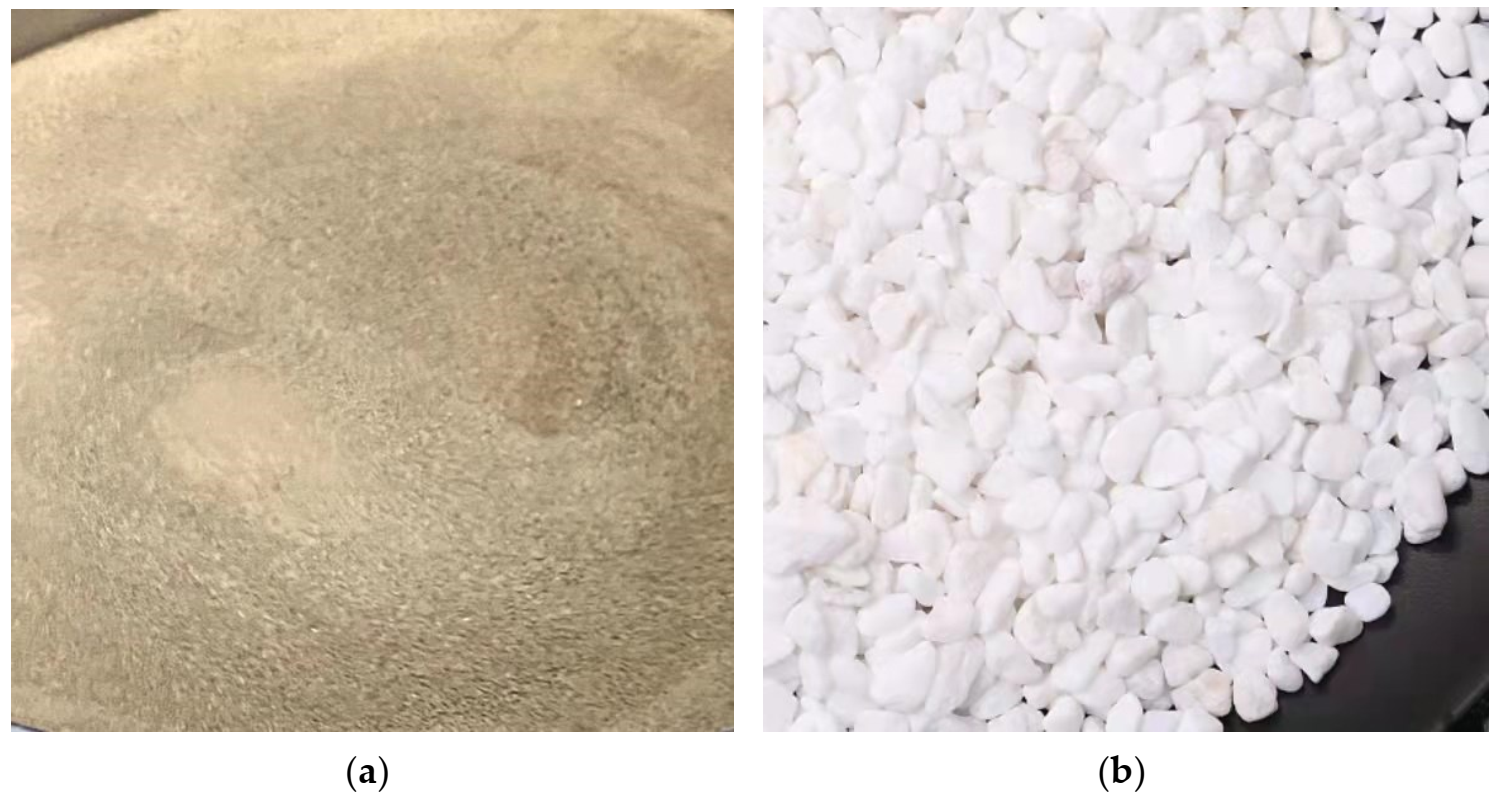


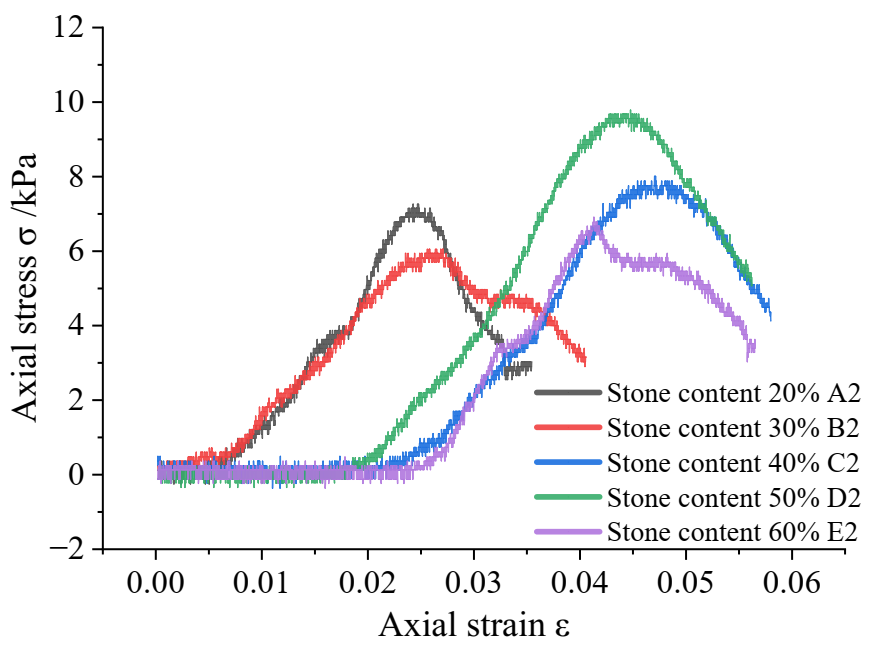
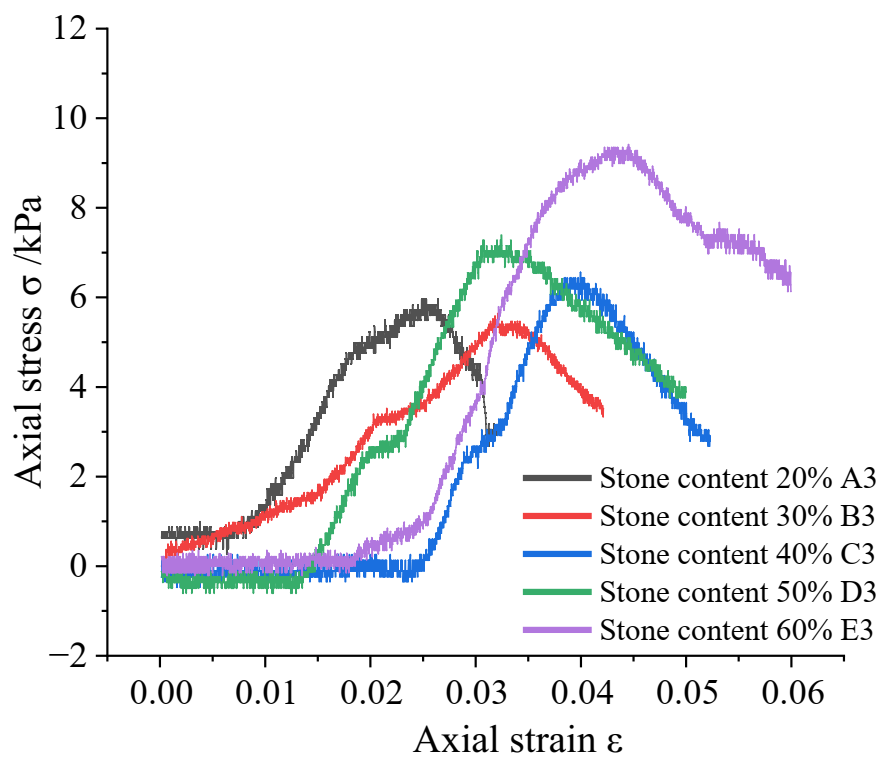


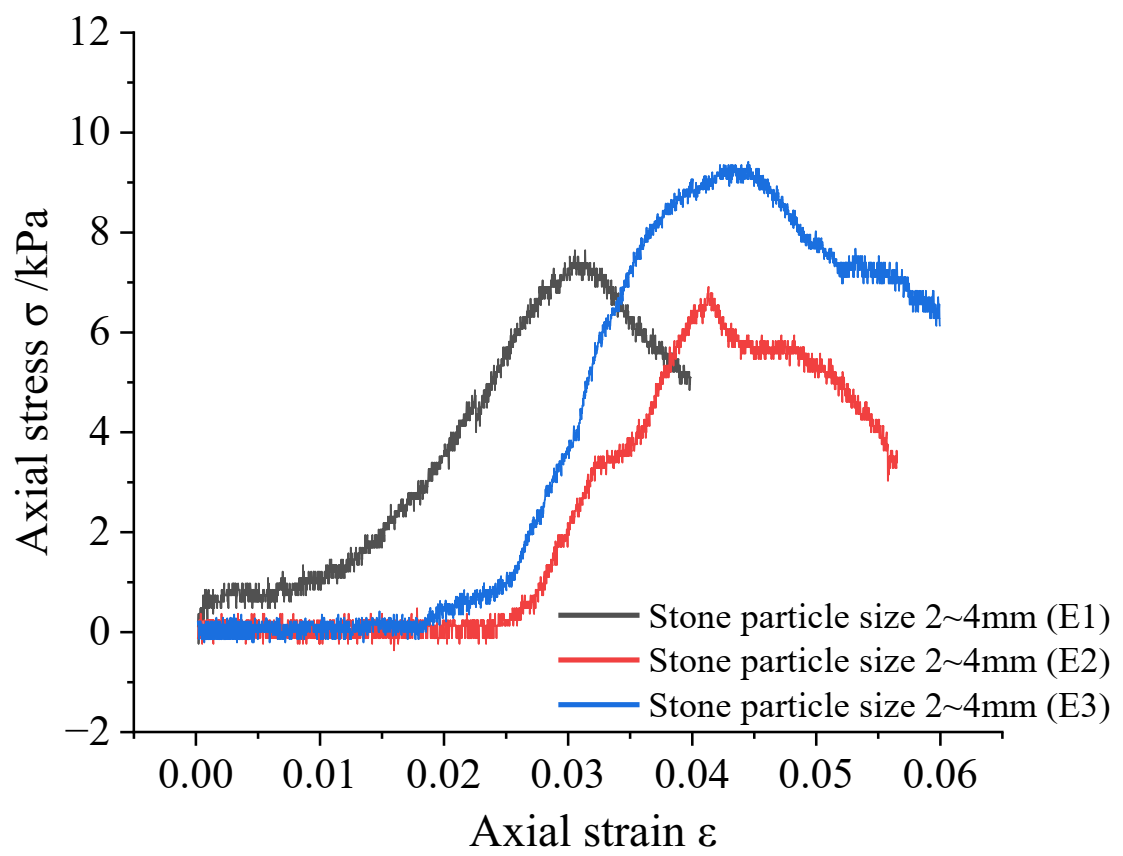

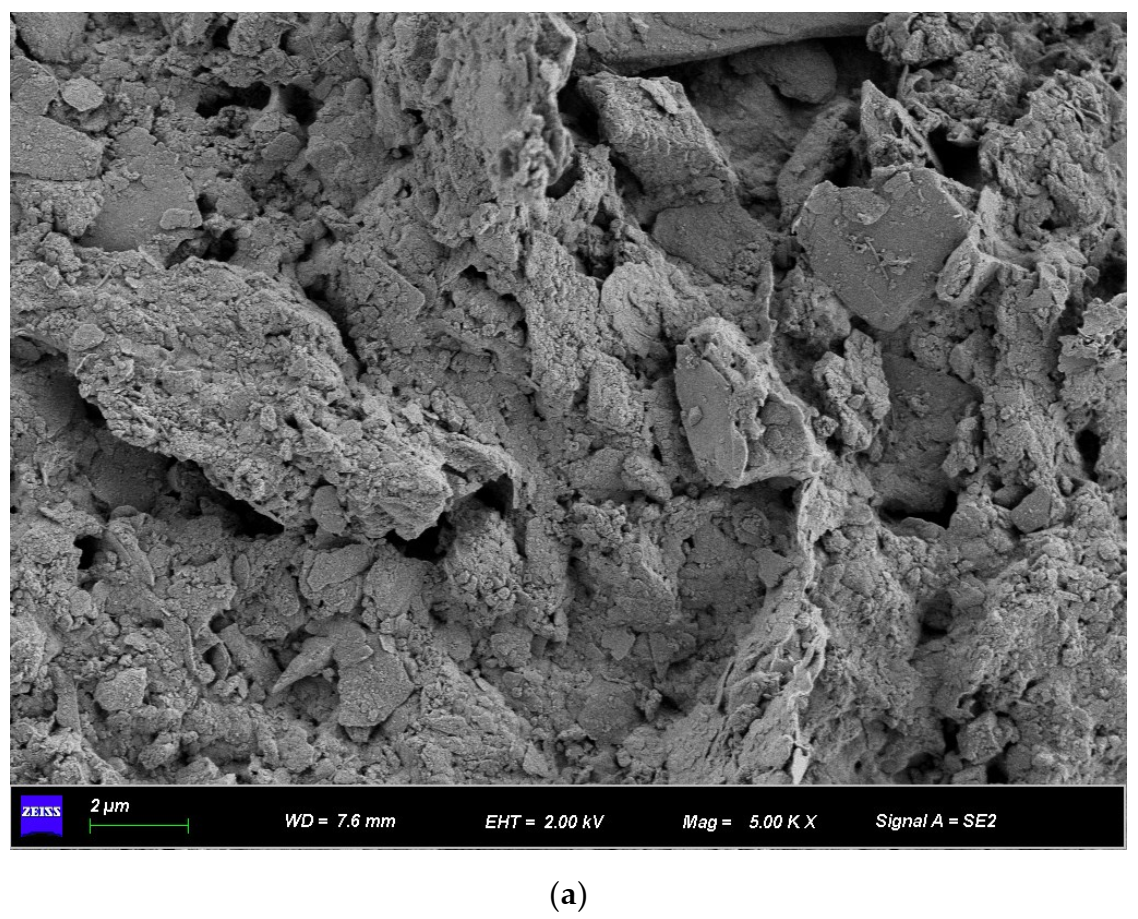
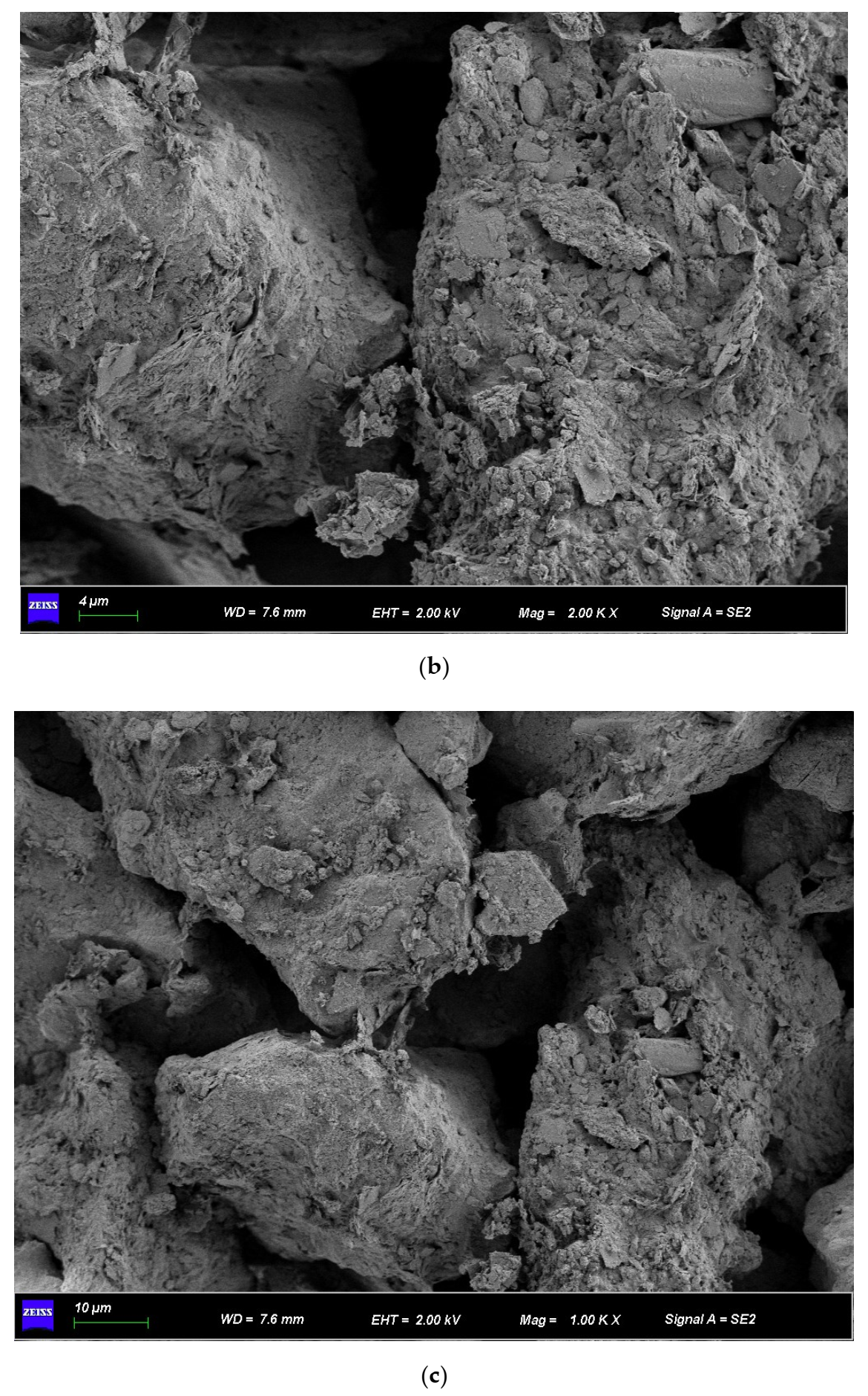
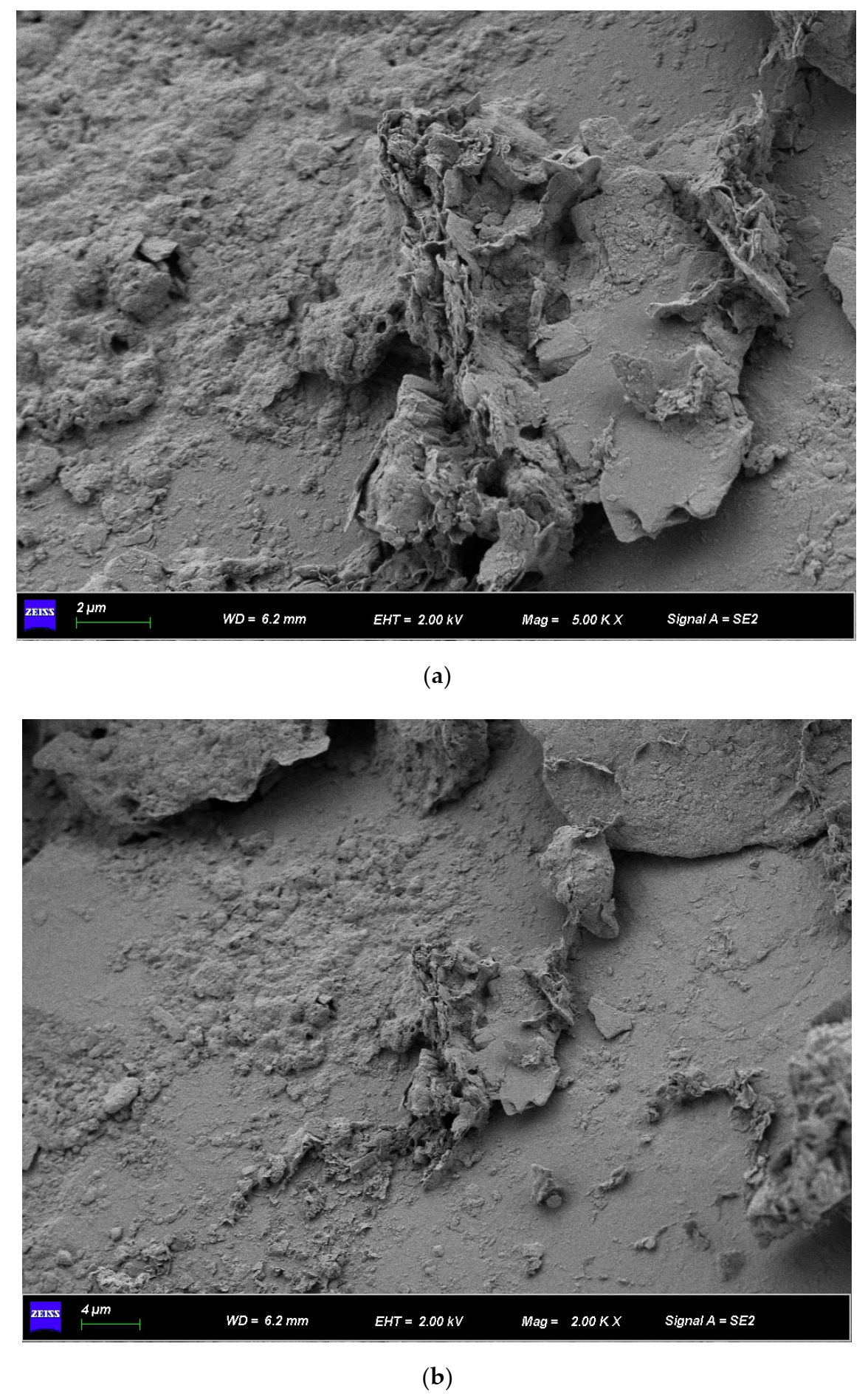
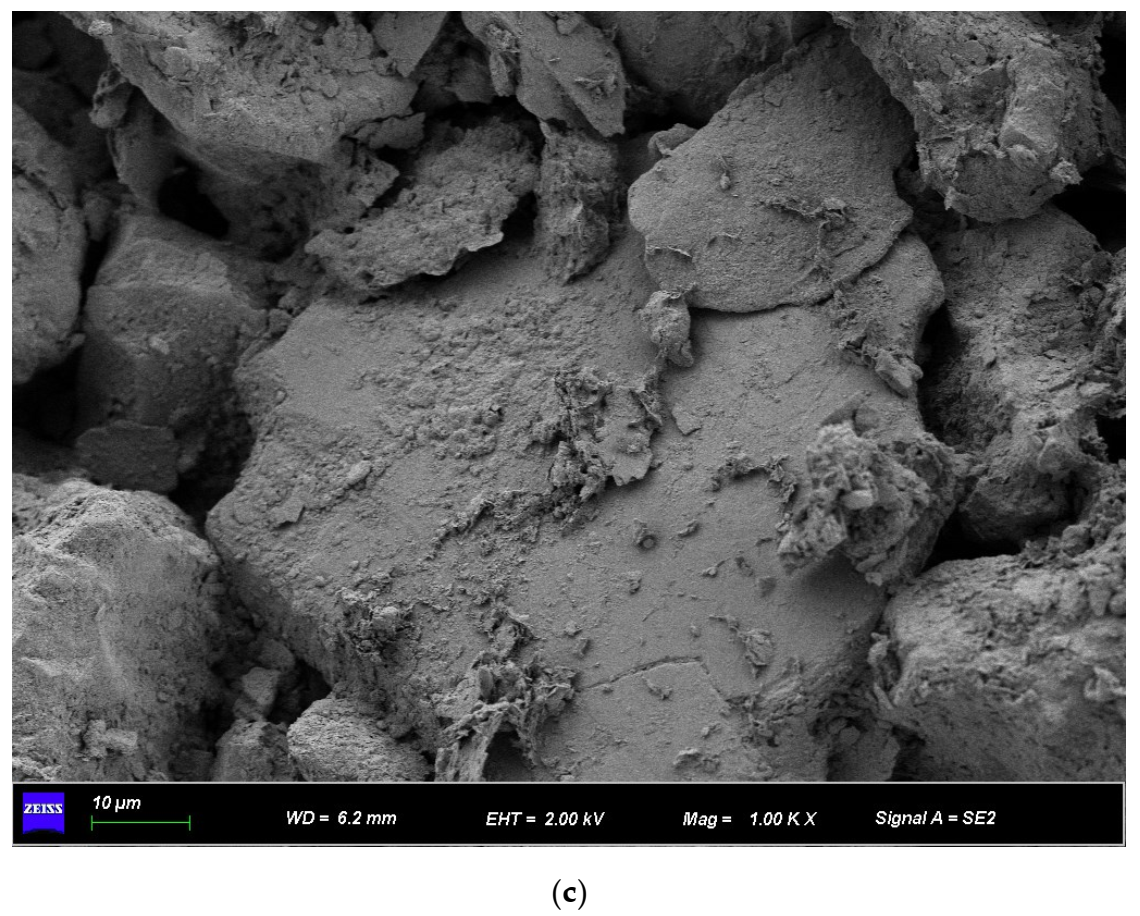
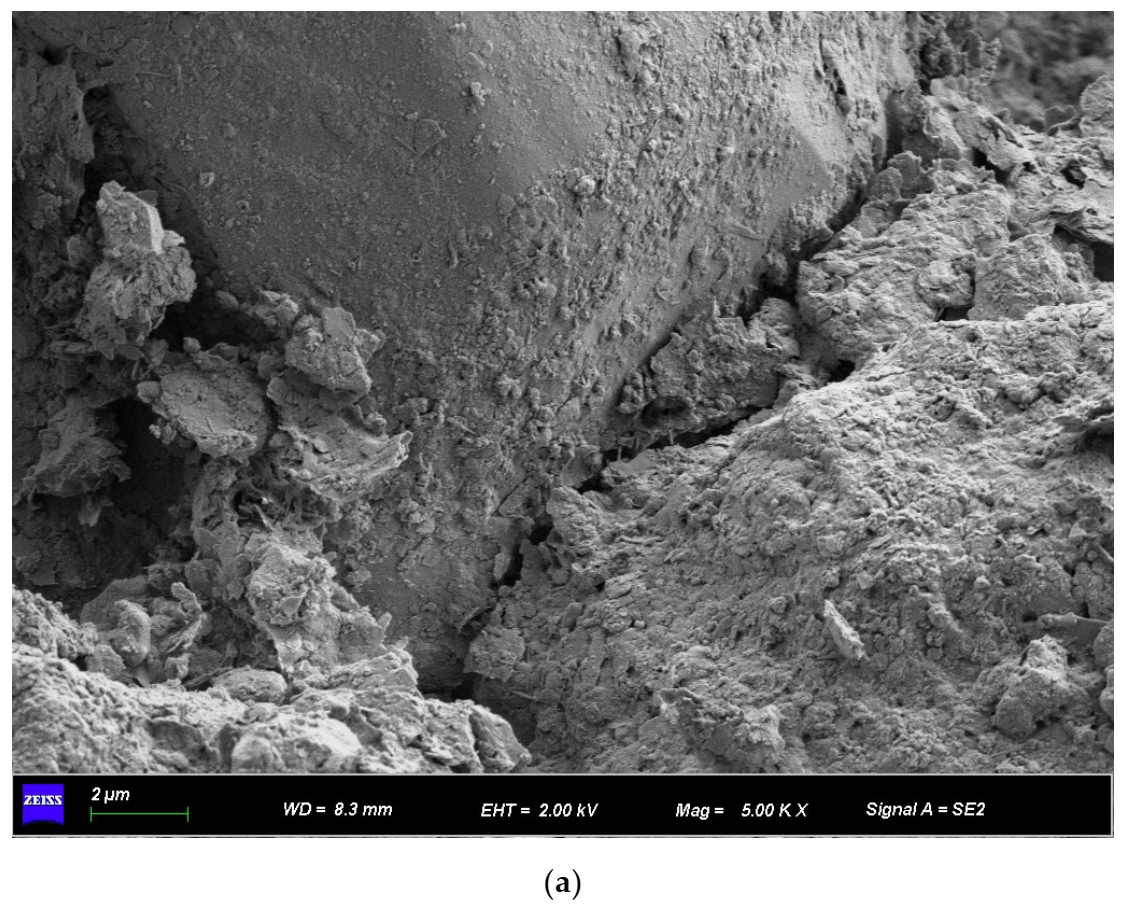
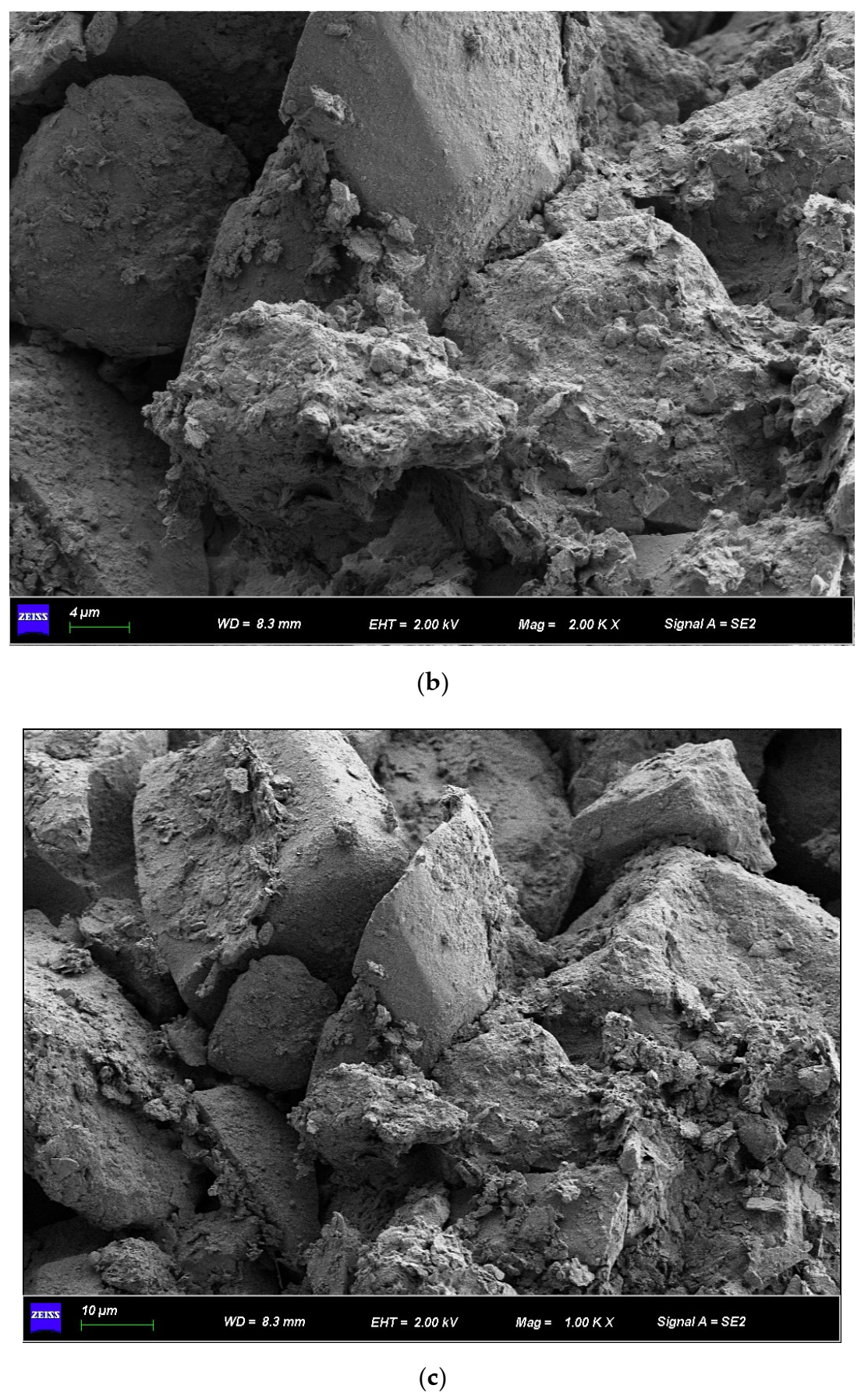
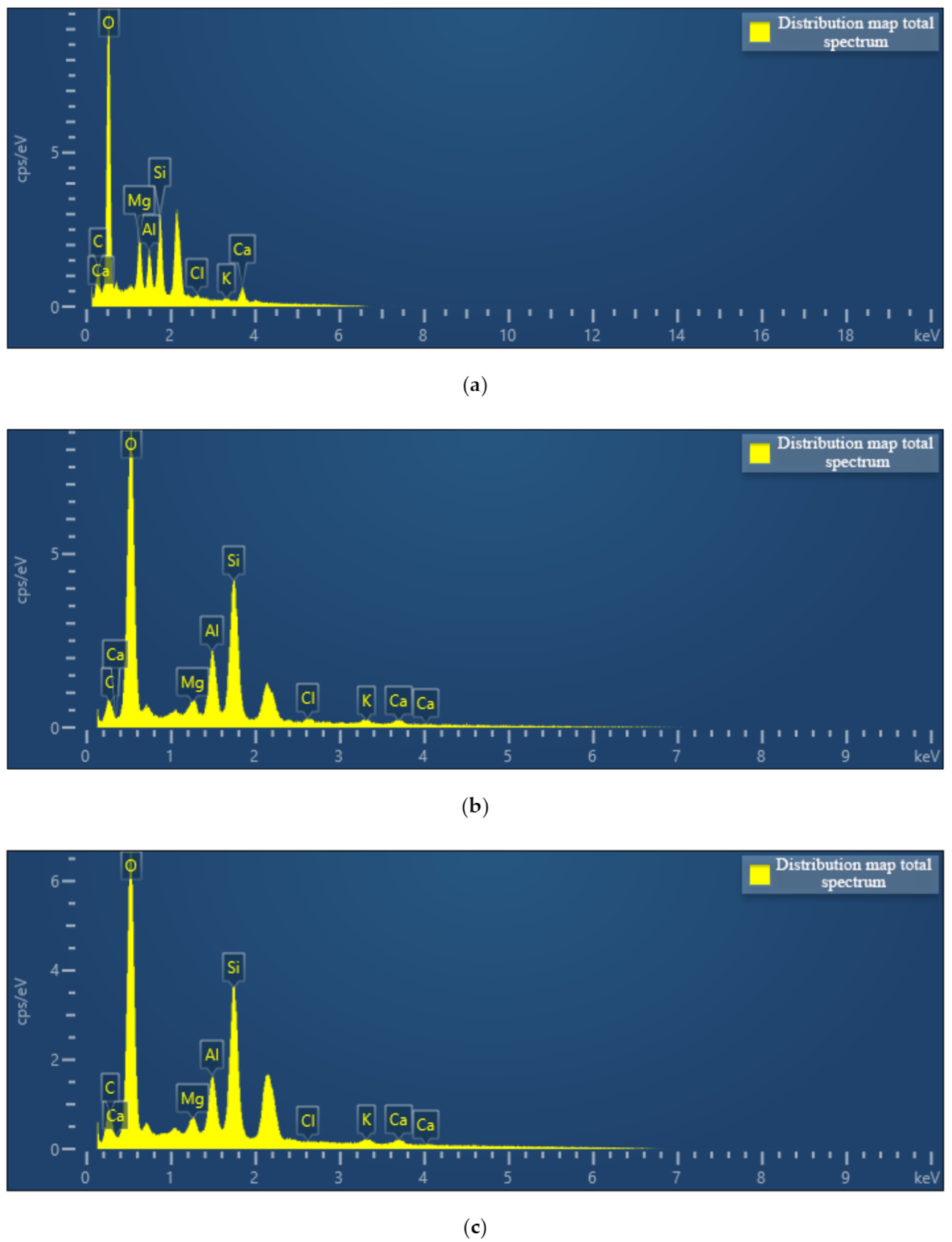
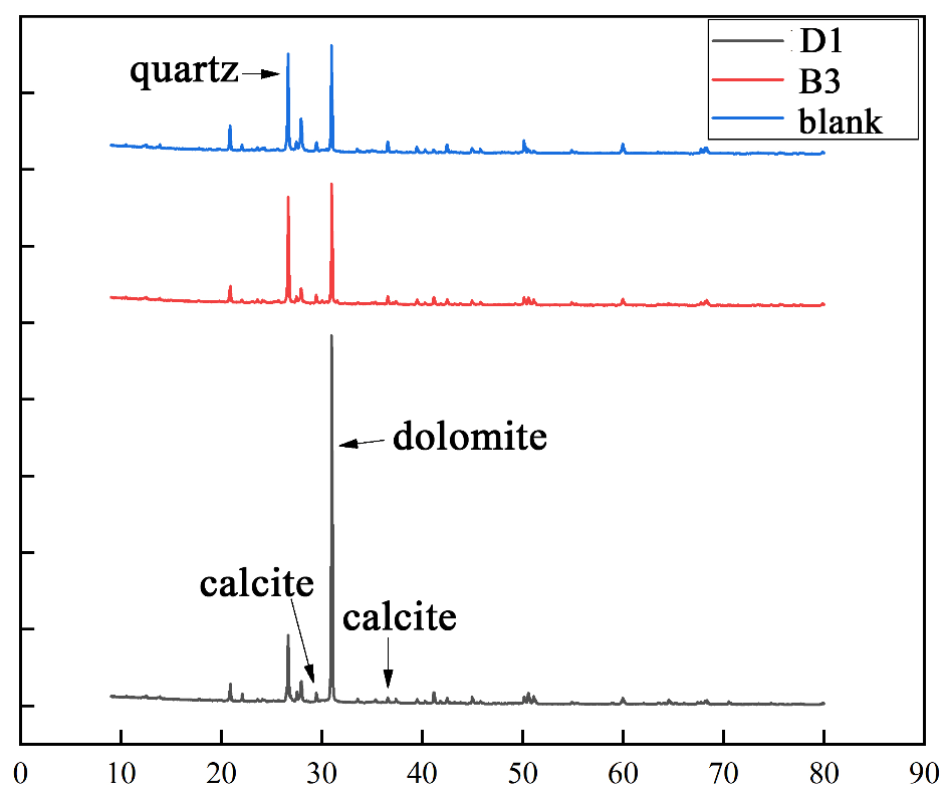
| Soil Sample Name | Particle Composition mm | Void Ratio e | Moisture Content w/% | Liquid Limit wl/% | Plastic Limit wp/% | Plasticity Index ip | Soil Specific Gravity gs | Dry Density ρd | |
|---|---|---|---|---|---|---|---|---|---|
| Silt | d ≤ 0.075 87% | 0.075 < d ≤ 0.1 23% | 0.54 | 5% | 21.52 | 15.54 | 5.98 | 2.7 | 1.7265 |
| Particle Size | 20% | 30% | 40% | 50% | 60% | |
|---|---|---|---|---|---|---|
| Rock Content | ||||||
| 0.2–0.4 cm | A1 | B1 | C1 | D1 | E1 | |
| 0.4–0.6 cm | A2 | B2 | C2 | D2 | E2 | |
| 0.6–0.9 cm | A3 | B3 | C3 | D3 | E3 | |
| Phase Name | Chemical Formula | Sample (Phase Content, Weight Percentage, wt%) | ||
|---|---|---|---|---|
| B3 | D1 | Blank | ||
| Illite | KAl2Si3AlO10(OH)2 | 8.8% | 7.6% | 8.3% |
| Kaolinite | Al4(OH)8Si4O10 | 0.9% | 0.6% | 0.6% |
| Quartz | SiO2 | 33.0% | 20.3% | 30.2% |
| Microcline Feldspar | KAlSi3O8 | 5.8% | 4.0% | 6.0% |
| Albite | NaAlSi3O8 | 11.4% | 13.9% | 20.0% |
| Chlorite | (MgFe)6(SiAl)4O10(OH)8 | 6.2% | 3.2% | 8.9% |
| Calcite | CaCO3 | 3.1% | 2.9% | 3.7% |
| Dolomite | CaMgCO3 | 30.0% | 46.3% | 18.7% |
| Amphibole | Al3.2 Ca3.4 Fe4.02 K0.6 Mg6 Na Si12.8 O44 (OH)4 | 0.8% | 1.2% | 3.6% |
Disclaimer/Publisher’s Note: The statements, opinions and data contained in all publications are solely those of the individual author(s) and contributor(s) and not of MDPI and/or the editor(s). MDPI and/or the editor(s) disclaim responsibility for any injury to people or property resulting from any ideas, methods, instructions or products referred to in the content. |
© 2023 by the authors. Licensee MDPI, Basel, Switzerland. This article is an open access article distributed under the terms and conditions of the Creative Commons Attribution (CC BY) license (https://creativecommons.org/licenses/by/4.0/).
Share and Cite
Sun, Y.; Tuo, Y.; Lv, J.; Wang, G. Influence of Different Particle Size and Rock Block Proportion on Microbial-Solidified Soil–Rock Mixture. Appl. Sci. 2023, 13, 1325. https://doi.org/10.3390/app13031325
Sun Y, Tuo Y, Lv J, Wang G. Influence of Different Particle Size and Rock Block Proportion on Microbial-Solidified Soil–Rock Mixture. Applied Sciences. 2023; 13(3):1325. https://doi.org/10.3390/app13031325
Chicago/Turabian StyleSun, Yongshuai, Ya Tuo, Jianguo Lv, and Guihe Wang. 2023. "Influence of Different Particle Size and Rock Block Proportion on Microbial-Solidified Soil–Rock Mixture" Applied Sciences 13, no. 3: 1325. https://doi.org/10.3390/app13031325
APA StyleSun, Y., Tuo, Y., Lv, J., & Wang, G. (2023). Influence of Different Particle Size and Rock Block Proportion on Microbial-Solidified Soil–Rock Mixture. Applied Sciences, 13(3), 1325. https://doi.org/10.3390/app13031325





